The fastest cooking times come from containers with strategic depths that maximize heat distribution. You'll get superior results using shallow pans under 3 inches for sautéing and searing, while stockpots should be deep enough (8-20 quarts) to fully submerge ingredients. Dutch ovens work best at 4-5 inches deep, and glass containers perform effectively at 2-3 inches. For solar cooking, set focal heights at 1/4 of aperture length, while ceramic bowls excel at 3½ inches deep. Metal containers, especially in pressure cooking, should stay between 2.5-3 inches. Understanding these depth sweet spots can transform your cooking efficiency and results.
Shallow Pans Under 3 Inches
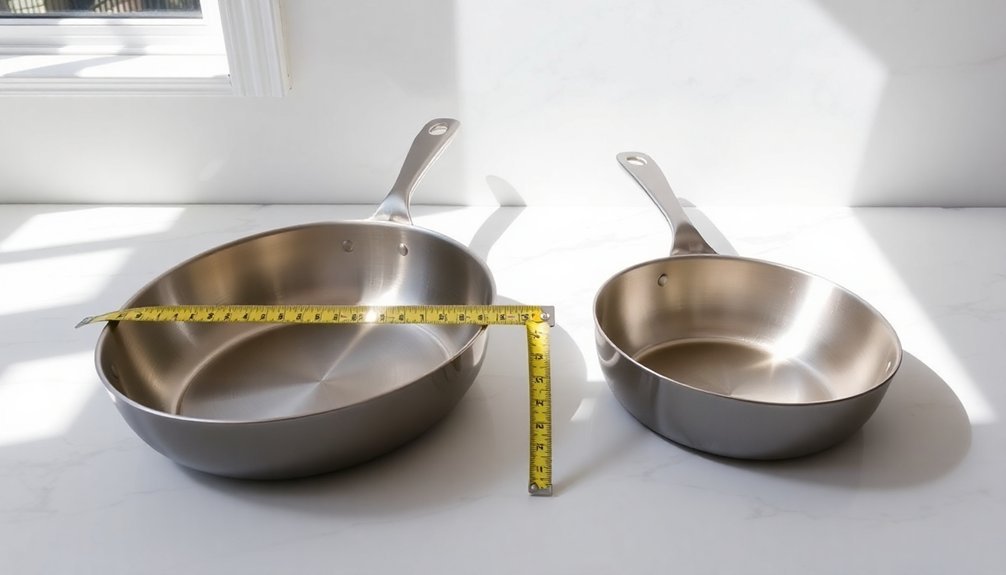
A shallow pan's design revolutionizes cooking efficiency in your kitchen. With a depth of less than 3 inches, these pans guarantee your food cooks evenly and quickly through superior heat distribution.
You'll notice faster cooking times because heat penetrates more effectively through thinner layers of food. When you're using a shallow pan, keep your food depth under 2 inches for best results.
The pan's design excels at multiple cooking techniques – you can sauté vegetables, sear steaks, or shallow fry with just ¼ to ½ inch of oil. Most shallow pans feature tri-ply construction with stainless steel and aluminum layers, making them ideal for even heating and induction cooking. The rounded corners enhance stirring and cleaning efficiency significantly.
You'll also appreciate their versatility, as they're typically oven-safe at high temperatures and come with comfortable, stay-cool handles.
Standard Stockpot Depths
Moving from shallow pans to deeper vessels, standard stockpots offer specific advantages for long-cooking recipes like broths and soups.
You'll find stockpots with capacities ranging from 8 to 20 quarts, with 12 quarts being ideal for most home cooking needs.
Your stockpot's depth isn't just about capacity – it's essential for proper ingredient submersion and flavor extraction.
When you're making stocks, the deep sides guarantee bones, vegetables, and herbs stay completely covered.
While the pot's depth increases with capacity, you'll want to take into account practical aspects like storage space and ease of handling.
Most stockpots take 45-50 minutes to reach a rolling boil at maximum capacity.
Don't worry too much about heat distribution along the sides – it's the pot's base that matters most.
Focus on finding a stockpot with sturdy handles and a depth that allows for easy straining once your stock is done.
Deep Dutch Oven Measurements
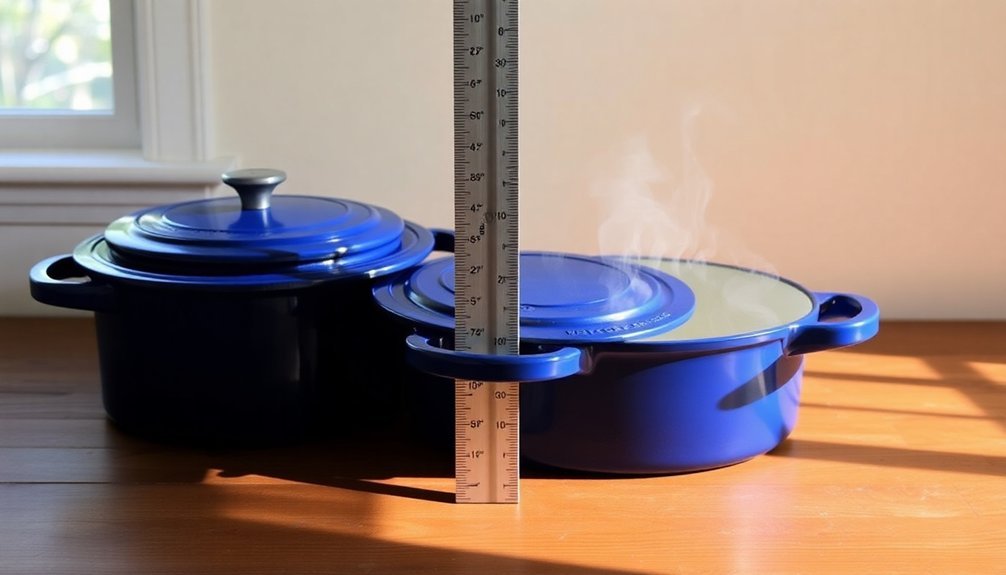
When you're comparing Dutch oven depths, you'll find that deeper models offer greater versatility for large cuts of meat and bigger batch cooking compared to standard depths.
The increased height in deep Dutch ovens affects heat distribution, typically requiring more coals or higher temperatures to maintain even cooking throughout the vessel's volume.
Your cooking times may vary based on the volume-to-height ratio, as deeper models need careful heat management to guarantee consistent results from top to bottom. For example, a 12-in deep model provides a 9.3-quart capacity ideal for feeding groups of 8-10 people.
Standard Depth Range Comparison
Deep Dutch ovens typically range from 4 to 5 inches in depth, striking an ideal balance between cooking capacity and heat distribution.
You'll find this standard depth in popular models like the Camp Chef Deep 12, which measures 5 inches deep. This consistent depth guarantees even cooking results whether you're using it indoors or outdoors.
When choosing a Dutch oven depth, consider these key factors:
- A 4-5 inch depth accommodates most recipes while maintaining maximum heat circulation throughout your food
- Standard depths work well for both layered dishes and large cuts of meat without compromising cooking performance
- These measurements allow for easier storage and handling while providing enough volume for typical family-sized meals
Whether you're braising, stewing, or baking, you'll find that standard-depth Dutch ovens offer versatility without sacrificing cooking efficiency.
Heat Distribution Benefits
Thanks to their superior construction, Dutch ovens with a 4-5 inch depth deliver exceptional heat distribution that transforms your cooking experience.
You'll notice the thick cast iron walls spread heat evenly throughout the pot, preventing hot spots that often plague thinner cookware. This even heating is vital when you're browning meat or slow-cooking dishes.
The heavy lid works to trap moisture and heat, ensuring your food cooks uniformly while preserving flavors and aromas.
You'll find this particularly beneficial for braises, stews, and roasts, where tender results are essential.
What's more, you'll save energy since Dutch ovens maintain steady temperatures at lower heat settings. This efficiency means you won't need to constantly adjust the temperature or add extra liquid during cooking.
Volume to Height Ratios
Understanding the volume-to-height ratio of your Dutch oven proves essential for achieving ideal cooking results.
You'll find that a 12-inch deep Dutch oven with a 5-inch depth offers an 8-qt capacity, while a 14-inch deep version provides 12 quarts. For most home cooking needs, you'll want to evaluate how these ratios affect your cooking time and heat distribution.
- Shallow Dutch ovens distribute heat more evenly and work better for smaller cuts of meat, making them ideal for quick-cooking dishes.
- Deeper vessels with larger capacities excel at cooking bigger portions and are perfect for feeding 10-12 people.
- A standard 12-inch Dutch oven serves as a versatile middle ground, accommodating most recipes while maintaining efficient cooking times.
Glass Container Sweet Spots
When you're using glass containers for cooking, optimal heat distribution depends considerably on container depth, with shallower 2-3 inch depths typically heating more evenly than deeper vessels.
You'll find that glass thickness plays a vital role in cooking speed, as thinner-walled containers (around 2.5mm) conduct heat more rapidly than thicker ones, though they're more susceptible to thermal shock.
The ideal volume-to-temperature balance occurs in medium-sized containers holding 3-4 cups of food, allowing heat to penetrate thoroughly while maintaining the thermal properties that make glass an excellent cooking vessel.
Optimal Glass Heat Distribution
Glass containers offer remarkable heat distribution properties that make them ideal for consistent cooking results. You'll find that glass spreads heat evenly across all surfaces, eliminating hot spots that can lead to uneven baking.
When using glass, remember to reduce your oven temperature by 25 degrees compared to metal pans, as glass retains heat longer and continues cooking even after removal from the oven.
- Preheat your oven before inserting glass containers to prevent thermal shock and potential breakage
- Let cold glass containers warm to room temperature for 30-60 minutes before baking
- Adjust standard recipe temperatures down by 25 degrees when using glass instead of metal
These nonporous containers won't retain odors or rust, making them versatile for both cooking and storage while ensuring your food stays fresh and evenly cooked.
Thickness Impact On Speed
Finding the right glass container thickness can greatly impact your cooking speed and efficiency. While you might assume thicker containers heat food faster, that's not always the case. The relationship between thickness and heating time isn't direct – factors like surface area and mass play significant roles.
You'll get the best results using borosilicate or tempered glass containers that are thick enough to handle heat safely but not so thick that they slow down cooking.
When choosing your container, focus on the overall shape and size rather than thickness alone. Bowls with larger surface areas will heat food more quickly than narrow, deep containers.
Remember to check that your glass is microwave-safe and free from damage. For best results, avoid containers with chips or cracks, as they can compromise both safety and heating efficiency.
Volume-to-Temperature Balance
Building on our understanding of container thickness, mastering the volume-to-temperature balance in glass containers will greatly improve your sous vide cooking results.
You'll want to use 8oz jars for ideal heat transfer and fill them to a level that allows for expansion without overflowing. Keep lids finger-tight to release air and vapor while cooking, and make sure your containers are fully submerged in the water bath.
- Select containers that match your food quantity – larger volumes need longer cooking times and may heat unevenly.
- Maintain proper spacing between containers to allow water circulation for consistent temperature distribution.
- Consider the specific heat capacity of glass when timing your recipes, as it affects how quickly and evenly your food cooks.
Remember that different foods perform better in different-sized containers – custards and semi-solids work best in smaller jars, while larger cuts of meat may require bigger vessels.
Optimal Solar Cooking Heights
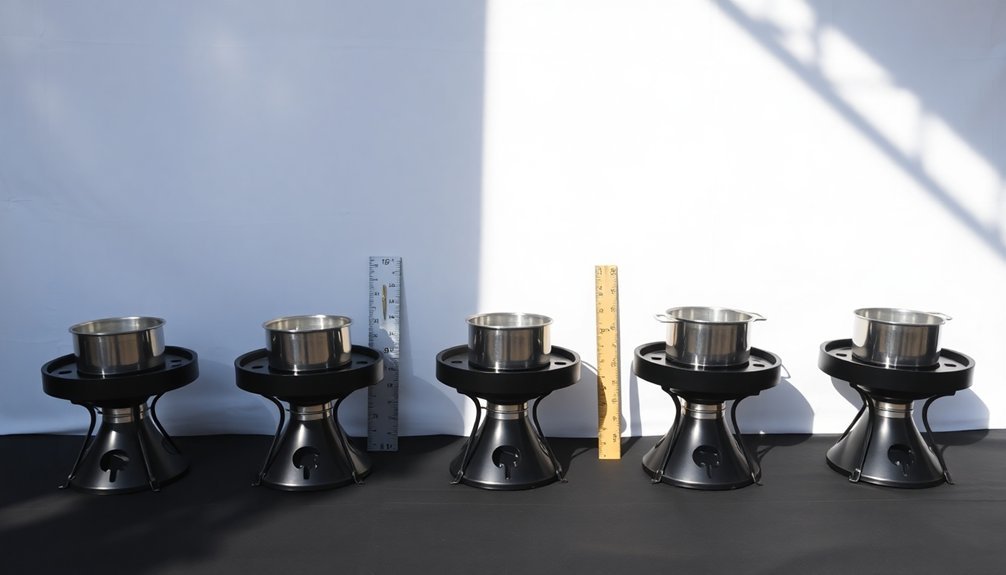
Determining the proper height configuration of your solar cooker can greatly impact its cooking efficiency. You'll want to orient your box cooker with a longer east-to-west dimension to maximize sunlight exposure throughout the day. This configuration reduces the need for frequent repositioning while maintaining consistent cooking temperatures.
| Height Element | Ideal Configuration |
|---|---|
| Box Orientation | East-West longer dimension |
| Reflector Angle | Adjustable for sun position |
| Focal Point | 1/4 of aperture length |
| Cooking Time | 11:00 AM – 3:00 PM best |
| Seasonal Setup | More winter adjustments |
For parabolic cookers, set your focal height at one-fourth of the aperture length to achieve the best angle tolerance. You'll need to adjust your reflectors more frequently during winter months, while summer allows for longer unattended cooking periods.
Ceramic Bowl Depth Range
While solar cooker heights affect cooking efficiency, the depth of ceramic bowls plays an equally important role in optimizing your cooking results.
You'll want to work with bowls that have a depth of around 3½ inches, which provides ideal heat distribution while maintaining structural integrity. When selecting ceramic bowls for cooking, you'll need to verify they're oven-safe and fired at temperatures above 2372°F to withstand regular use.
- Choose bowls with ½-inch thick walls to balance heat retention and cooking efficiency
- Keep the thinnest portions around ⅛ inch to prevent hot spots while maintaining durability
- Aim for a 6-inch diameter with a slightly concave bottom to promote even heat distribution
Remember to check for oven-safe markings and avoid using vintage ceramics that might contain harmful glazes.
Metal Container Perfect Depths
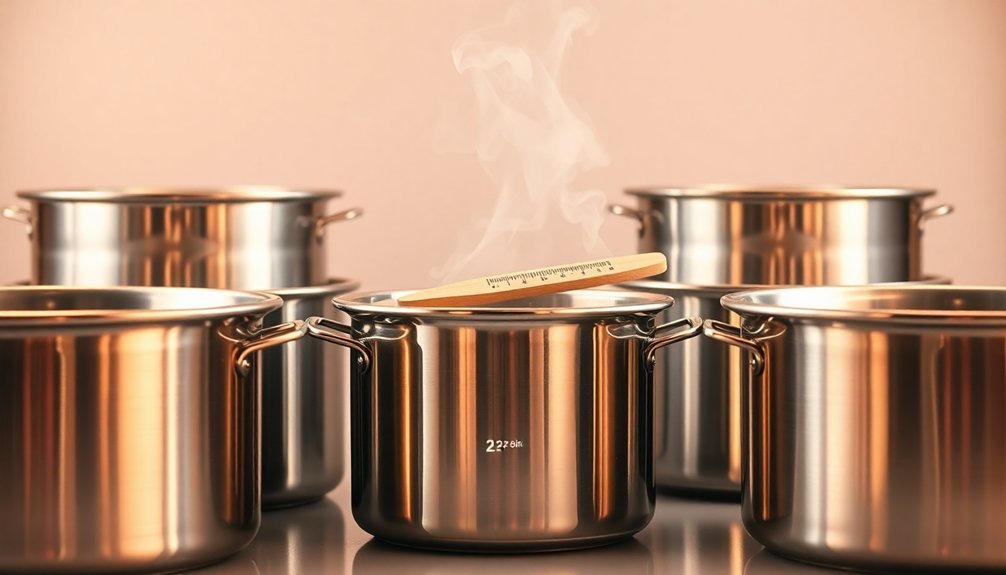
To achieve ideal cooking results in your Instant Pot, metal containers should maintain a depth between 2.5 to 3 inches, with stainless steel offering the most effective heat transfer at this range.
You'll want to choose containers with a 7-inch or 6.5-inch diameter to guarantee proper heat distribution and retention.
When using these depths, you'll get maximum performance with high-pressure cooking for 10 minutes, followed by a 15-minute natural release.
For foamy foods, opt for slightly taller containers while maintaining the recommended diameter.
If you're using anodized aluminum, you can expect temperatures up to 239°F, while stainless steel reaches about 237.4°F.
Remember to adjust your water levels accordingly – whether you're using a trivet or placing the container directly in the pot.
Frequently Asked Questions
How Does Altitude Affect Recommended Container Depths for Different Cooking Methods?
At higher altitudes, you'll need shallower pans for boiling and frying to compensate for lower temperatures, but deeper containers for pressure cooking and covered dishes to maintain moisture and cooking efficiency.
Can Mixing Different Container Materials in One Cooking Session Impact Heating Times?
Yes, you'll experience uneven heating when mixing container materials since they heat at different rates. Your ceramic and glass items will heat faster than plastic ones, causing inconsistent cooking times across dishes.
What Depth Ratios Work Best When Nesting Containers for Double-Boiler Setups?
You'll want your inner container to sit 1 inch into the outer pot, maintaining a 2-inch gap below. This 1:2 depth ratio guarantees proper steam circulation and prevents overheating your ingredients.
Do Container Depth Requirements Change When Cooking With Induction Heating Systems?
You'll find that container depth isn't critical for induction heating, as it primarily depends on the base's magnetic properties. Just guarantee your pan's bottom is flat and matches the cooking zone's diameter.
How Do Seasonal Temperature Variations Affect Optimal Container Depth Choices?
You'll need deeper containers in hot seasons to protect roots and maintain moisture, while shallower containers work better in cooler weather since they warm up faster and help roots develop properly.
In Summary
You'll find your cooking times dramatically reduced by choosing the right container depths. Whether you're using a 2-inch shallow pan for quick sautés or an 8-inch stockpot for hearty stews, proper depth selection makes all the difference. Remember, shallower isn't always better – each cooking method has its ideal depth range. Master these measurements, and you'll transform your cooking efficiency while maintaining perfect results.


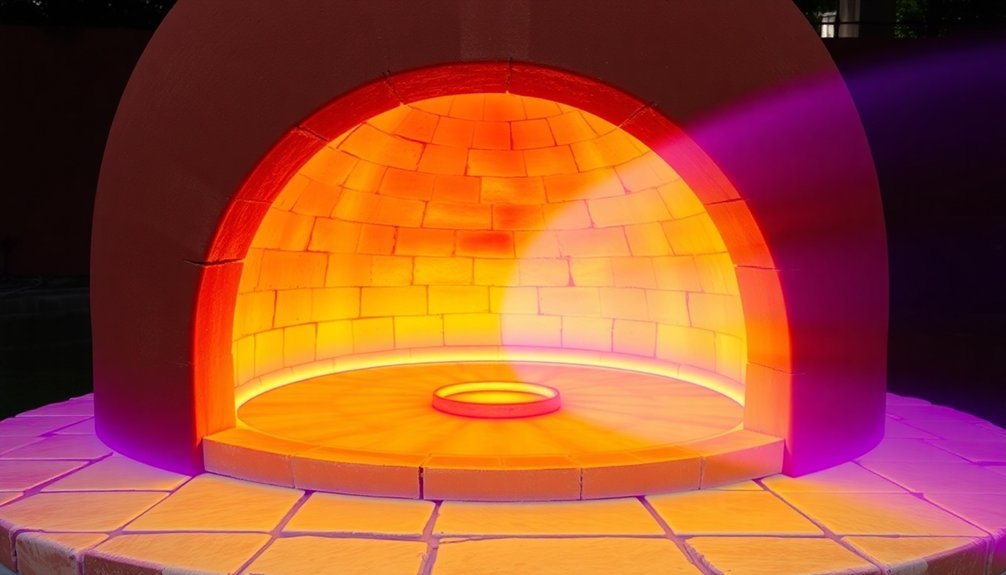
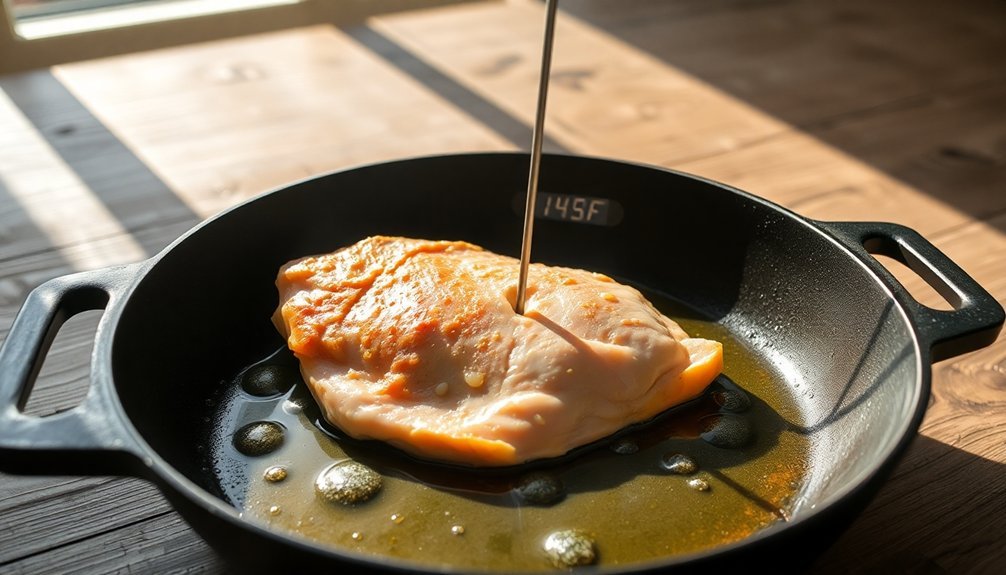
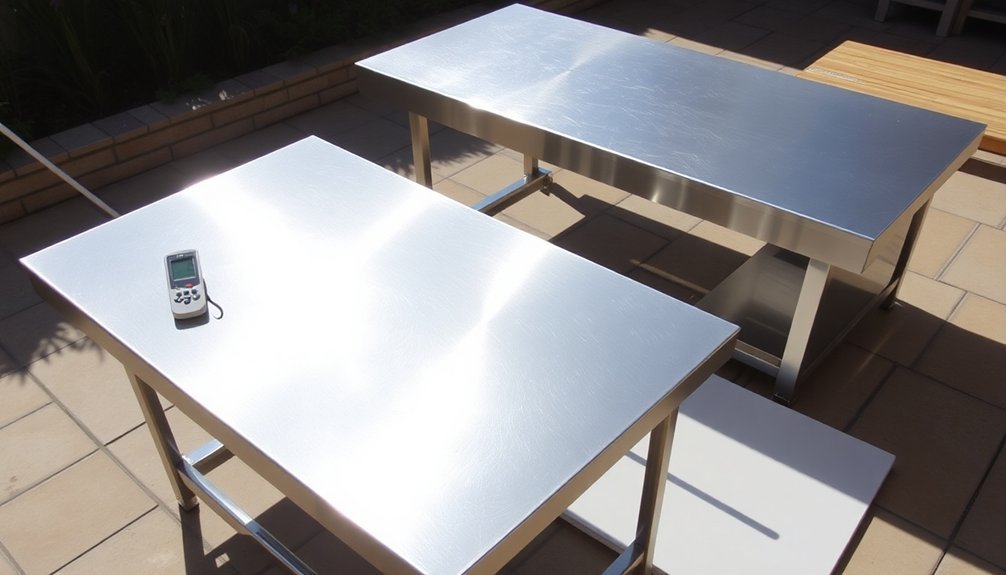
Leave a Reply